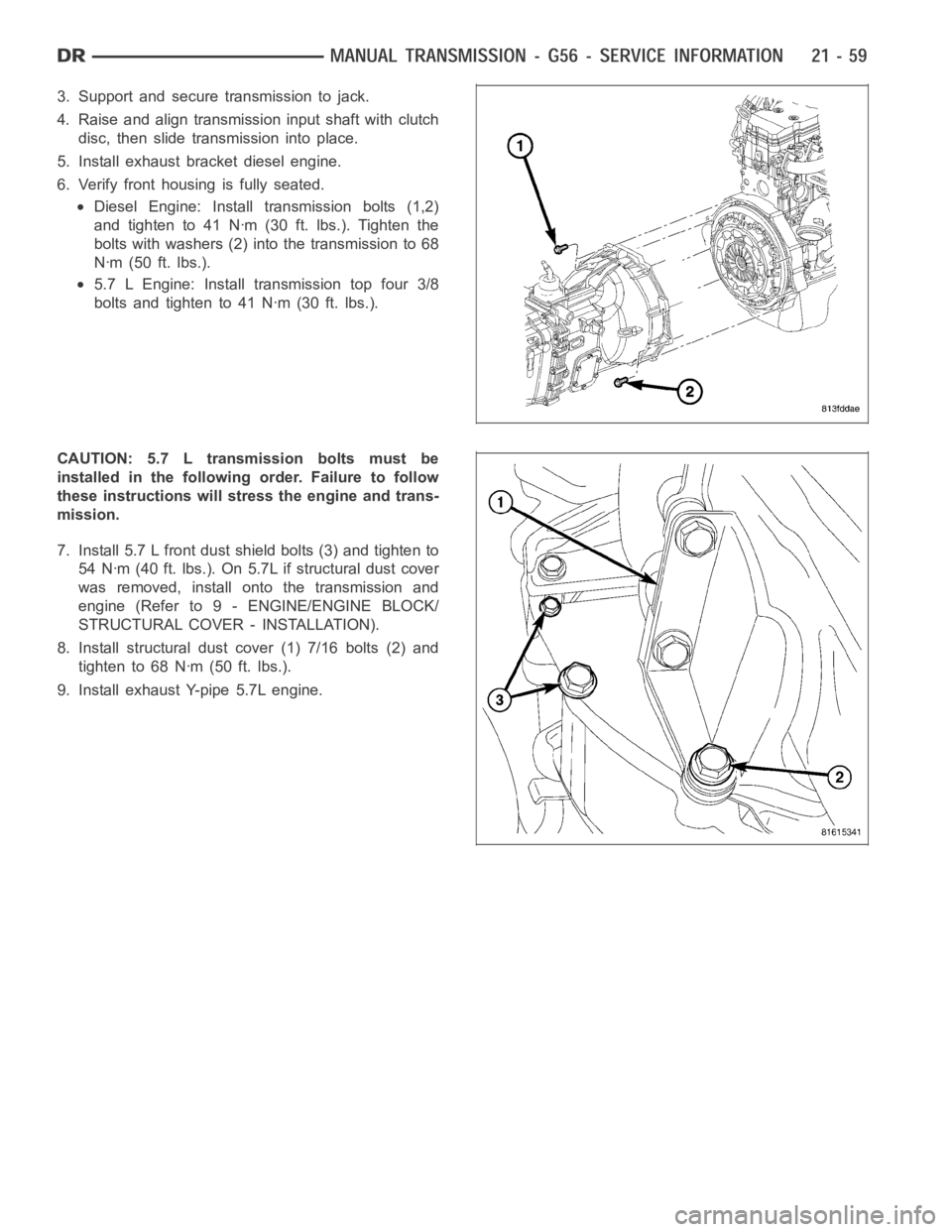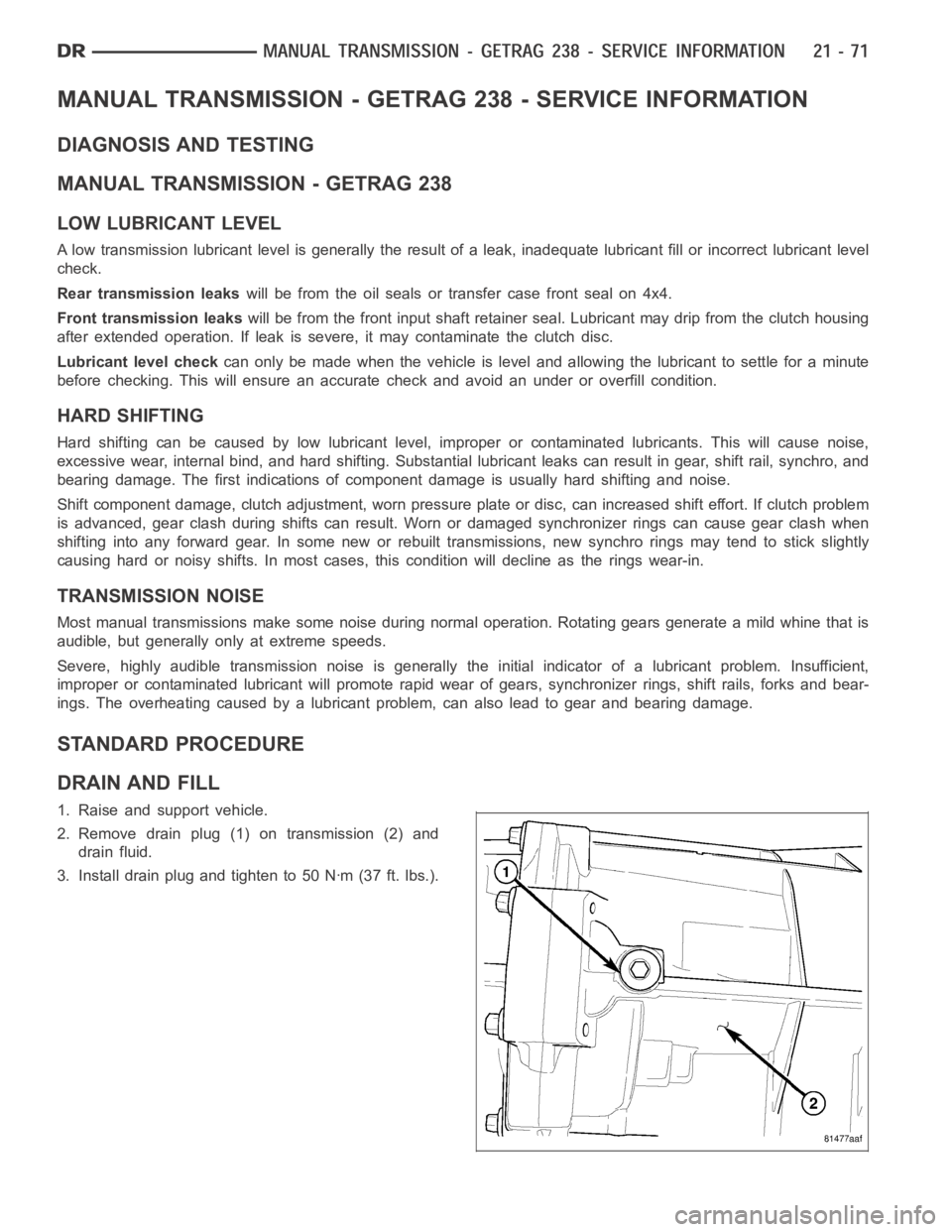Page 2580 of 5267

3. Support and secure transmission to jack.
4. Raise and align transmission input shaft with clutch
disc, then slide transmission into place.
5. Install exhaust bracket diesel engine.
6. Verify front housing is fully seated.
Diesel Engine: Install transmission bolts (1,2)
and tighten to 41 Nꞏm (30 ft. lbs.). Tighten the
bolts with washers (2) into the transmission to 68
Nꞏm (50 ft. lbs.).
5.7 L Engine: Install transmission top four 3/8
bolts and tighten to 41 Nꞏm (30 ft. lbs.).
CAUTION: 5.7 L transmission bolts must be
installed in the followingorder. Failure to follow
these instructions will stress the engine and trans-
mission.
7. Install 5.7 L front dust shield bolts (3) and tighten to
54 Nꞏm (40 ft. lbs.). On 5.7L if structural dust cover
was removed, install onto the transmission and
engine (Refer to 9 - ENGINE/ENGINE BLOCK/
STRUCTURAL COVER - INSTALLATION).
8. Install structural dust cover (1) 7/16 bolts (2) and
tighten to 68 Nꞏm (50 ft. lbs.).
9. Install exhaust Y-pipe 5.7L engine.
Page 2586 of 5267
8. Measure the gap (1) between the fixture shaft (2)
and the fixture plunger (3). Repeat measurement
on the opposite side of the countershaft cup and
bearing. The average of the two measurements,
will be the size of the countershaft select shim.
9. Install select shim in front housing countershaft
bearing cup bore and install bearing cup.
SPECIFICATIONS
MANUAL TRANSMISSION-G56
TORQUE SPECIFICATIONS
DESCRIPTION Nꞏm Ft. Lbs. In. Lbs.
Fill Plug 57 42 -
Drain Plug 57 42 -
Front to Rear Housing
Bolts58 43 -
Input Shaft Retainer Bolts 23 17 -
Shift Tower bolts 23 17 -
5-6 Shift Fork Bolts 58 43 -
Shift Rail Support bolts 58 43 -
Reverse Idler Gear Shaft
Bolt58 43 -
P.T.O. Cover Bolts 58 43 -
Clutch Release Pivot Ball 22 16 -
Page 2592 of 5267

MANUAL TRANSMISSION - GETRAG 238 - SERVICE INFORMATION
DIAGNOSIS AND TESTING
MANUAL TRANSMISSION - GETRAG 238
LOW LUBRICANT LEVEL
A low transmission lubricant level is generally the result of a leak, inadequate lubricant fill or incorrect lubricant level
check.
Rear transmission leakswill be from the oil seals or transfer case front seal on 4x4.
Front transmission leakswill be from the front input shaft retainer seal. Lubricant may drip from theclutchhousing
after extended operation. If leak is severe, it may contaminate the clutchdisc.
Lubricant level checkcan only be made when the vehicle is level and allowing the lubricant to settle for a minute
before checking. This will ensure an accurate check and avoid an under or overfill condition.
HARD SHIFTING
Hard shifting can be caused by low lubricant level, improper or contaminated lubricants. This will cause noise,
excessive wear, internal bind, and hard shifting. Substantial lubricantleaks can result in gear, shift rail, synchro, and
bearing damage. The first indications of component damage is usually hardshifting and noise.
Shift component damage, clutch adjustment, worn pressure plate or disc, can increased shift effort. If clutch problem
is advanced, gear clash during shifts can result. Worn or damaged synchronizer rings can cause gear clash when
shifting into any forward gear. In some new or rebuilt transmissions, new synchro rings may tend to stick slightly
causing hard or noisy shifts. In most cases, this condition will decline asthe rings wear-in.
TRANSMISSION NOISE
Most manual transmissions make some noise during normal operation. Rotating gears generate a mild whine that is
audible, but generally only at extreme speeds.
Severe, highly audible transmission noise is generally the initial indicator of a lubricant problem. Insufficient,
improper or contaminated lubricant will promote rapid wear of gears, synchronizer rings, shift rails, forks and bear-
ings. The overheating caused by a lubricant problem, can also lead to gear and bearing damage.
STANDARD PROCEDURE
DRAIN AND FILL
1. Raise and support vehicle.
2. Remove drain plug (1) on transmission (2) and
drain fluid.
3. Install drain plug and tighten to 50 Nꞏm (37 ft. lbs.).
Page 2594 of 5267
13. Remove starter motor (2), structural dust cover (3)
bolts to clutch housing, dust shield (1) bolt and
suspension crossmember (4).
CAUTION: Do not remove structural dust cover
from engine block. If cover is removed clutch
housing and cover must be aligned with the
engine.
14. Remove exhaust pipe from the exhaust manifolds.
15. Support engine with adjustable jack stand and
wood block.
16. Support and secure transmission (1) to a trans-
mission jack (2) with safety chains.
17. Remove bolts from the rear transmission mount.
18. Remove the rear crossmember (2) and transmis-
sion mount (1).
19. Remove bolts attaching transmission to the
engine.
20. Move transmission rearward until input shaft is
clear of clutch disc and pressure plate. Then
lower jack and remove transmission from under
vehicle.
Page 2606 of 5267
31. Remove clutch release bearing support bolts (2)
and retainer (1).
32. Insert seal Puller 9667 through one input shaft
seal (1) disassembly hole (2).
33. Remove input shaft seal with Remover 9667 (1)
and Slide Hammer C-3752 (2).
Page 2612 of 5267
MAINSHAFT
1. Remove fifth gear synchronizer clutch body (1)
from 5-6 synchronizer hub (2).
2. Remove fifth gear synchronizer friction ring (1) from
5-6 synchronizer hub (2).
Page 2614 of 5267
6. Remove 5-6 synchronizer hub (1) with three jaw
puller (2) and Button 9618-2 (3). Position jaws
under sixth gear clutch body (4).
7. Remove sixth gear (1) from mainshaft (2).
Page 2623 of 5267
Shift Rails:Inspect shift rails, bushings, and bearing
for wear. Verify main shift rail (1) bearings (2) roll
smoothly.
Clutch Release Bearing Support:Inspect clutch
release bearing support (1) release bearing slide sur-
face (2) for damage.
Housing/Tail housing:Inspect sealing and mating
surfaces are free of burrs and nicks. Inspect alignment
dowels are tight and in good condition. Inspect shift
rail bushings for wear.